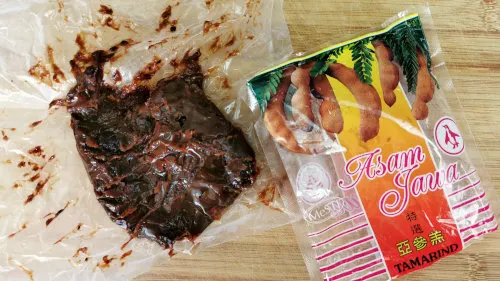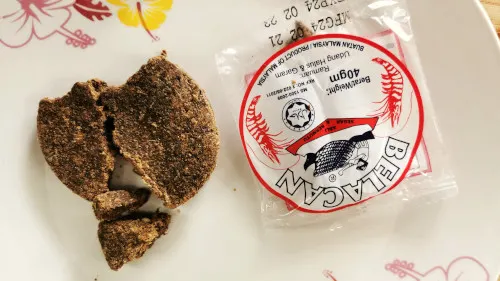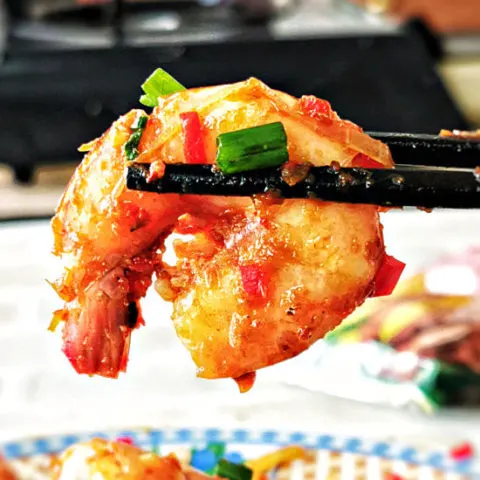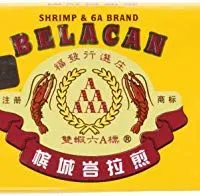Sambal prawn (sambal udang) is the favorite Malaysian dish prepared with sambal tumis, a relish made with chilies, tamarind, dried shrimps, and belacan.
It is cooked with sambal, the chili paste with a balance of spicy, savory, tangy flavor. Sambal prawn is usually served as the side dish. The sauce takes center stage as it is extraordinary when served with nasi lemak or steamed rice.
In this recipe, I cook the prawn with sambal tumis, which is required to slow cook until it turns into a highly aromatic paste.
I made a batch of sambal tumis today and used part of it to prepare the sambal prawn. Since sambal can be kept in the freezer and stable for a few months, making a large batch is worthwhile as I can use it to prepare other dishes.
I will explain how to make the sambal first, followed by how to cook it with the prawn.
This sambal prawn recipe is prepared with my tested sambal tumis recipe, which I have posted on this blog. It is suitable as the all-in-one paste to stir-fry kangkung (local water spinach), eggplant, and topping for fried fish and, of course, the prawn in this recipe.

1. Ingredients for sambal tumis (Malaysian style)
Here is a brief explanation of each ingredient for making sambal tumis.
Use a combination of fresh and dried red chilies
- Chili is the most crucial ingredient for sambal. First, remove the seeds of the fresh red chilies, then cut them into large pieces. Although I use the electric blender to process it into chili paste, it is still better to cut them into sections to reduce the workload of the blender. Again, I would suggest removing the seeds as the sambal can become very spicy.
- In my opinion, the sambal tastes best when using a combination of fresh and dried chilies. Dried red chilies have a more pungent taste than their fresh counterpart and are spicier. Since it is dry, the blender will not blend it effectively unless they are rehydrated. Some people soak the dried chilies in hot water to rehydrate them. I prefer to boil it for ten minutes instead of soaking it because it is faster to soften it. Besides that, you need to cut and remove as many seeds as possible. This way allows you to use more chilies to get more flavor without causing the sambal to become overly hot and spicy.
- Place the fresh and softened dried chilies into the blender. You need to add some water to help swirl up the chiles in the blender rather than stay idle. Let it blend for two to three minutes or until it forms a paste without visible chili pieces.
Onion and garlic
Onion is the ingredient that forms the body of sambal paste. Besides that, I also include some garlic for added flavor. Then, blend the onion and garlic with some water to form a smooth paste, which takes a shorter time than the chilies since they are easier to blend.
Tamarind, belacan, and dried shrimps
A good sambal tumis is not complete without tamarind juice. Tamarind is called Asam Jawa in Malaysia and comes with pulp and seeds in a pasty form. It has a unique tangy to sour and tart flavor, which is quite essential for sambal prawns. First, you need to soak the pulp in water, then remove the pulp and seeds through a strainer to get the tamarind water. You can use store-bought tamarind paste as a substitute for fresh tamarind.

Belacan is the local shrimp paste made with fermented shrimp and salt. I would strongly suggest adding it to sambal tumis since it has strong umami to any stir-fried dishes. The flavor of belacan is best after it is toasted until dry and aromatic. This process is quite similar to toasting the spices before using them to prepare curry dishes. Place the belacan in a pan over low heat and break it into large pieces. When it is dry, it will break down further into large granules with a distinct aroma.

Dried shrimp is an add-on ingredient for the sambal. It is not mandatory, but it certainly makes all my sambal stir-fries taste better. Soak the dried shrimps in water for ten minutes, then remove and drain. You have the option to chop it coarsely or blend it until it looks like meat floss.
2. How to cook the sambal
Here is a brief instruction on how to cook the sambal tumis.
- Heat the oil in a wok over medium heat.
- Add the onion and garlic paste, then saute for three minutes.
- Pour the blended chili paste into it, followed by the tamarind juice, toasted belacan, and dried shrimps.
- Season with palm sugar and salt.
- Cook for about thirty minutes or until the oil starts to separate and float on the surface.
3. Tips to make sambal tumis
- Remember to remove the seed of the chilies. By doing so, you can use more chilies to get a better flavor without being too spicy.
- Use sufficient oil for cooking the sambal. By doing so, you do not need to use additional oil when you use the sambal for stir-frying the prawn later.
- Cook the sambal over low heat until it is dry and the color turns darker. The prolonged cooking will remove the raw taste of the chili.
- Use a combination of fresh and dry chili for cooking sambal. You can increase the amount of fresh chili for a stronger chili taste. On the contrary, too much dried chili can cause the taste of the sambal to be too pungent and choky.
- Toast the belacan before using it for cooking sambal for the best result.
- Tamarind juice is a must. Therefore, I add more tamarind juice while cooking the prawn in the next stage.
- Use palm sugar for better flavor. Alternatively, use brown sugar.
- Use plenty of onion. Onion forms the body of sambal. The sambal will become too dilute if you use too little onion.
4. Prepare the prawn
I purchased 1kg of medium-size prawn today for making the sambal prawn.
Some cooks prefer to remove the shells and head so that it is more convenient to eat. Others like to remove only the head and legs so that it has a better presentation. Of course, you still need to perform the usual, i.e., devein and clean the prawn thoroughly.
The net weight after removing the shell and trim off the legs for 1kg of prawn is about 700g.
There is nothing else you need to do for the preparation since all the flavors are coming from the sambal. So the only thing is to make sure that the prawn is fresh.
5. Cook the sambal prawn
Once the sambal has cooked to the desired texture and consistency, you are about to enjoy this outstanding prawn dish in no time.
Here are the steps:
- Cut two medium-size onions into rings, then add half into the sambal. Stir-fry it for two minutes.
- Pour the fresh prawn into the sambal. Coat the prawn with the spice paste and let it cook for two minutes.
- Meanwhile, Pour the tamarind juice into the sambal through a strainer to filter out the pulp and seeds.
- Season with salt and ground white pepper.
- Stir-fry over medium heat until the prawn is cooked. You may need to add a few tablespoons of water (it depends on whether you drain the prawn well) if it is too dry.
- I also cut some scallion and red chili finely. Add half to the prawn so that it will stick onto the prawn.
- Dish out and sprinkle the remaining scallion and chilies to garnish. Serve.
Note: You can make a variation by adding a small amount of coconut milk during stir-frying.
Other sambal recipes
This sambal is the basis for some popular Malaysian stir-fry dishes, for example, sambal squid, egg, and kangkung (water spinach). Therefore, it is worth making a large batch and keeping the extra for future use. In addition, it is stable in the refrigerator for a few days and can be stored for up to two months in the freezer without any noticeable flavor deterioration.
This sambal is also best for preparing the famous street food called prawn mee (Penang Hokkien mee) which is incredibly delicious. You can get the recipe that I published on this blog earlier.

Sambal prawn - How to prepare my favorite prawn in chili paste
Sambal prawn (sambal udang) is the favorite Malaysian dish prepared with sambal tumis, a relish made with chilies, tamarind, dried shrimps, and belacan.
It is cooked with sambal, the chili paste with a balance of spicy, savory, tangy flavor. Sambal prawn is usually served as the side dish. The sauce takes center stage as it is extraordinary when served with nasi lemak or steamed rice.
Ingredients
Ingredients A (sambal tumis)
- 120g onion
- 3 cloves garlic
- 4 tbsp vegetable oil
- 15g dried chili
- 80g red chili
- 2 tsp belacan
- 2 tsp palm sugar
- 2 tsp tamarind paste
- 1/2 tsp salt
- 10g dried shrimp
Ingredients B (for the prawn)
- 1kg medium-sized prawn (weight includes head and shell)
- 2 medium-sized onions, cut into rings
- 1 tbsp tamarind paste
- 1/2 tsp salt
- 1/4 tsp ground white pepper
- 3 tbsp water
- 1 red chili, chopped
- 1 stalk scallion, chopped
Instructions
To prepare the sambal tumis:
- Remove the seeds of the fresh red chilies, then cut them into large pieces.
- Cut the dried chilies into sections and remove the seeds. Boil them in water for ten minutes until soft. Remove and drain.
- Place the fresh and softened dried chilies into the blender. Let it blend for two to three minutes or until it forms a paste without visible chili pieces.
- Blend the onion and garlic with some water to form a smooth paste.
- Soak the tamarind pulp in water, then pass through a strainer to get the juice.
- Place the belacan in a pan over low heat and break it into large pieces. When it is dry, it will break down further into large granules with a distinct aroma.
- Soak the dried shrimps in water for ten minutes, then remove and drain. Blend it until it looks like meat floss.
- Heat the oil in a wok over medium heat.
- Add the onion and garlic paste, then saute for three minutes.
- Pour the blended chili paste into it, then the tamarind juice, toasted belacan, and dried shrimps.
- Season with palm sugar and salt.
- Cook for about thirty minutes or until the oil starts to separate and float on the surface.
To cook the prawn:
- Remove the head, legs, and deveined. Wash thoroughly and drain.
- Cut two medium-size onions into rings, then add half into the sambal. Stir-fry it for two minutes.
- Pour the fresh prawn into the sambal. Coat the prawn and let it cook for two minutes.
- Add the tamarind juice.
- Season with salt and ground white pepper.
- Stir-fry over medium heat until the prawn is cooked.
- Add half of the chopped scallion and red chili to the prawn and mix well.
- Dish out and sprinkle the remaining scallion and chilies to garnish. Serve.
Recommended Products
As an Amazon Associate and member of other affiliate programs, I earn from qualifying purchases.
-
 Navitas Organics Coconut Palm Sugar, 16 oz. Bag — Organic, Non-GMO, Gluten-Free, Sustainable
Navitas Organics Coconut Palm Sugar, 16 oz. Bag — Organic, Non-GMO, Gluten-Free, Sustainable -
 Tamicon Tamarind Paste
Tamicon Tamarind Paste -
 Belacan Shrimp Paste - Shrimp & 6A Brand (250g/8.82oz) Product of Malaysia
Belacan Shrimp Paste - Shrimp & 6A Brand (250g/8.82oz) Product of Malaysia -
Soeos Szechuan Dried Chili,Dry Szechuan Pepper, Dry Chile Peppers, Sichuan Pepper, Dried Red Chilies, 4oz, (Very Mild Spicy)
Nutrition Information:
Yield: 30 Serving Size: 1Amount Per Serving: Calories: 86Total Fat: 4gSaturated Fat: 1gTrans Fat: 0gUnsaturated Fat: 3gCholesterol: 75mgSodium: 476mgCarbohydrates: 3gFiber: 0gSugar: 1gProtein: 9g
This data was provided and calculated by Nutritionix on 8/29/2021

KP Kwan
Sunday 29th of August 2021
Hi, this is KP Kwan. I am happy to see you in this comment area, as you have read through my recipe. I am glad to reply to any questions and comments as soon as possible.